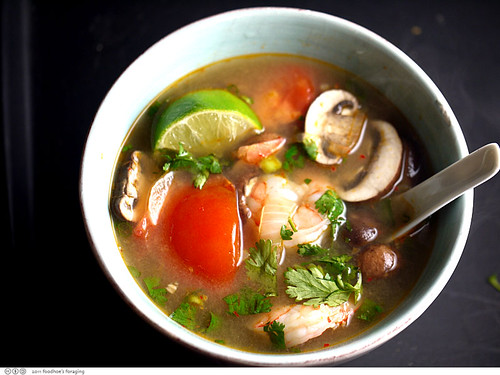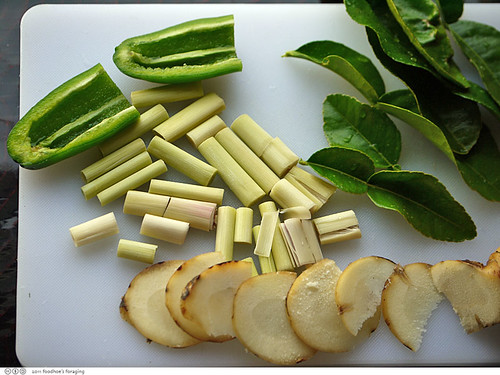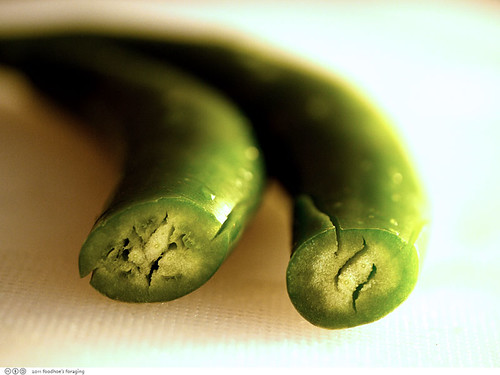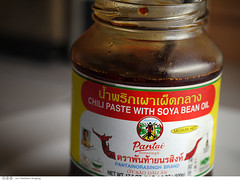
I'm making soups again now with the chilly Fall weather. This is one of our favorite recipes that I learned from Kasma who teaches Thai cooking classes in her home. It's flavorful and very satisfying, the heat from the chilies warms you through to your toes.
Ingredients
- 1/2 lb. prawns, or medium- to large-size shrimps, shells removed and butterflied (save shells for soup stock)
- 2-3 stalks fresh lemon grass
- 3 cups water, or mild soup stock, salted with fish sauce (nahm bplah) to the desired saltiness
- 6 thin slices fresh galanga (kah), or 2 dried pieces
- 3 fresh or dried kaffir lime leaves (bai ma-gkrood)
- 8-10 whole Thai chillies (prik kee noo), stem removed and bruised with the back of a cleaver; or substitute with 2-3 sliced jalapeno or serrano peppers
- 1/2 a small onion, halved again and sliced crosswise 1/4-inch thick
- 1-2 Tbs. roasted chilli paste (nahm prik pow);
- 3-4 Tbs. tamarind water: a chunk of wet tamarind, about the size of 1 Tbs., with the soft parts dissolved in 1/4 cup water, pulp removed
- 1 cup fresh brown mushrooms, sliced in 1/4-inch pieces, or 1 can whole straw mushrooms, drained
- 1 small tomato, cut in bite-size wedges (optional)
- 2 green onions, cut in thin rounds
- Juice of 1-2 limes, to desired sourness
- 1/2 cup cilantro leaves or short cilantro sprigs

Cut the bottom tip off the lemon grass stalks and discard the loose outer layer(s). Then cut each stalk into 1-inch sections at a slanted diagonal all the way up to the greener end, near the start of the grass blades, exposing the inner core. Smash each piece with the side of a cleaver or the end of a large knife handle to bruise, releasing the aromatic oils.
Place the cut lemon grass along with the prawn or shrimp shells and the water or stock in a soup pot. Bring to a boil, then reduce heat to low and simmer with a lid on for 15-20 minutes to draw out the flavors. Strain out the shrimp shells and some of the lemon grass.

Add the sliced galanga, kaffir lime leaves, bruised Thai chillies (or substitute) and sliced onion. Simmer a couple of minutes, then add the roasted chilli paste (nahm prik pow), tamarind water and fresh brown or straw mushrooms. This is the roasted chili paste below.

Heat stock to a boil and simmer for a couple of minutes. Stir in the tomato wedges (if using), green onions and prawns or shrimps. After 20-30 seconds, turn off heat, add lime juice to the desired sourness and the cilantro. Do not let the prawns or shrimps overcook. Serve immediately.

Kasma's Notes and Pointers for Hot & Sour Soup:
Dtom yum is a light soup with practically no oil, and it contains the four main flavors – hot, sour, sweet and salty – accentuated with fresh aromatic herbs. (See Creating Harmonies with Primary Flavors.) It is the most popular soup in Thailand and can be found in the tiniest mom-and-pop village rice shop to the fanciest restaurant in Bangkok. No menu is without it, even in Thai restaurants overseas, and if there is no menu, as is the case in Thailand's rural areas, just speaking the magic words"dtom yum" is enough to procure a steaming bowl of the fragrant and stimulating soup.Dtom yum can be made with just about any type of seafood or meat, or vegetables for vegetarians. You can have a dtom yum gkai (gkai = chicken), dtom yum bplah (fish), dtom yum talay (mixed seafood), dtom yum hed (mushrooms), and so on.There are numerous ways of blending flavors, as you will notice from eatingDtom yum in various restaurants here or in Thailand. Flavors vary from place to place, from chef to chef and from pot to pot. But basically,dtom yum is hot and sour – hot from some kind of chilli pepper and sour primarily from lime juice – and has lemon grass as the leading herb flavor.
Most dtom yum in Thailand is made, of course, with Thai people's favorite chillies, prik kee noo, known now in the western world as "Thai chillies." In this recipe, the chillies are kept whole, so you and your guests can spot them easily and not bite into one unless you choose to. Simmering the chillies in the broth will flavor the soup with its special spicy flavor. If you can find red ones, they make the soup prettier and are even easier to spot, but if you want to insure a zero chance of a fiery accident, you may wish to simmer the chillies in the soup stock a few minutes and then strain them out entirely. Remember, the longer you cook chillies, the more their heat will cook out into the surrounding broth.
Alternatively, for a stronger roasted flavor, you may wish to use dried red chilli peppers. Roast them on a dry pan directly over a burner until the pods are dark red, turning frequently so they do not burn. Cut each roasted pepper into two or three segments and add to the soup. Keep in mind, however, that the nahm prik pow in the recipe already provides some roasted flavor.
© 1995 Kasma Loha-unchit.

